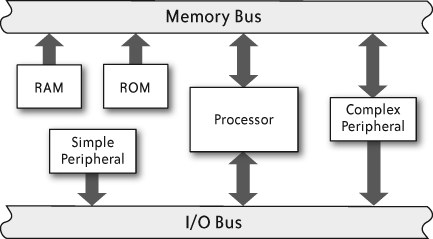The PC Architecture
The modern PC is a very complicated beast. Its hardware has been optimized and iterated over many times to produce a highly effective and generalized computing platform. However, it also carries with it legacy components and functionality designed to maintain its backward compatibility. In some ways this is a blessing. The basic architecture of an IA-32 machine has not changed since its advent in 1985 with the 386. In fact, in terms of system architecture, the 386 itself was not much of a departure from its x86 predecessors.
Although Figure 9-1 is in some ways grossly simplified, with some text changes and some duplication of boxes, this could easily pass as an architectural diagram for JPC itself.

Figure 9-1. Basic architecture of a modern PC
Designing the bulk of JPC was a relatively simple matter of
systems analysis, and mapping from the original system to JPC for the
bulk of the emulation is almost a 1:1 correspondence between the
hardware specs and the Java class. For example, a serial port in JPC
for example is represented by a single class,
SerialPort, that implements
HardwareComponent and
IOPortCapable. This simplistic approach gives rise to a design that is easy to understand and navigate, and on the whole, objects within the architecture are loosely coupled to each other. This gives JPC the benefit of being very flexible, so just as in a real machine, virtual ...
Get Beautiful Architecture now with the O’Reilly learning platform.
O’Reilly members experience books, live events, courses curated by job role, and more from O’Reilly and nearly 200 top publishers.

